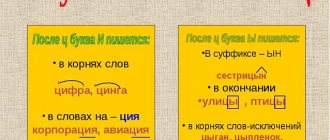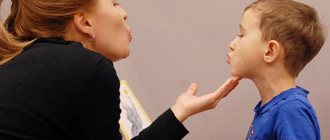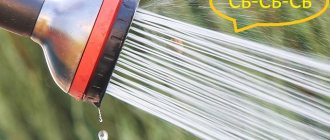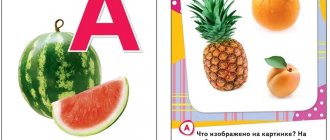Teaching children the correct pronunciation of sounds consists of several stages. First, you need to prepare the articulatory apparatus. The child must rehearse the position of the lips, the position of the tongue in front of the mirror, and be able to breathe correctly during speech. When the baby manages to pronounce the previously disobedient sound “s”, then further work is carried out on improving it, that is, primary pronunciation skills are formed. At this stage, the learned pronunciation is automated, first in syllables, and then in words. Only then, when the child speaks correctly without thinking, are communication skills developed.
In the article we will figure out how to automate “s” in words, how to consistently strengthen pronunciation first in syllables, then in short phrases, then move on to introducing “s” in sentences. Automation will gradually lead to the child involuntarily inserting the learned pronunciation into independent speech. This already happens reflexively, on a subconscious level, thanks to daily classes and exercises, which will be discussed later in the article.
Exercises for pronunciation of "s"
Children pronounce the isolated sound “s” first, repeating after the teacher or speech therapist. This stage should not be long. It is recommended to use onomatopoeic games only at the very beginning, when the baby has just learned to correctly articulate “s”. The emphasis in this case is on associations, for example, “repeat the bird’s whistle,” “tell me how the water makes noise,” “show me how the wind blows.” To help your child understand the difference between similar sounds, add associative exercises on “sh” and “s” to the game.
At the first stage, you can play the following games with your children:
- “Yula” - the speech therapist or mother spins the top, and while it is spinning, the child must repeat the learned sound “s”.
- “From bump to bump” - the baby is given a strip of paper with circles glued on. You can offer your child a small toy, such as a bunny, to help. He jumps from circle to circle, and the child repeats the sound “s” with each jump of the animal.
- “Talking pen” - the child is given a piece of paper on which long lines are drawn in dotted lines. The baby points them with his hand and pulls “c”.
- “Catch the ball” - the child throws a small ball or tennis ball from one hand to the other, while “catching” the “c”. You can play together. The mother throws the ball to the baby and pronounces the sound “s”. The child catches the toy and repeats “s” independently.
Lesson 1
Breathing exercises
"Harmonic". I. p. - stand straight, lower your arms. Place your palms on your tummy and take a deep breath through your nose. Hold your breath for 1-2 seconds. Exhale through your mouth. Development of exhalation force. Developing the correct direction of the air stream along the midline of the tongue
"Cold wind". Having drawn air into your lungs, blow forcefully through your lips extended forward with a tube. Bring the back of your hand to your mouth. You should feel a sharp, beating cold stream.
Exercises for lips and facial muscles
Game exercises
"Smile". “We are glad to meet a friend.” Stretch your lips in a smile to the limit and hold them in a tense position for some time. The teeth are closed. Repeat 3-4 times. "Cranky monkeys." Movements with closed lips to the right and left. (If you have difficulty, help with your index fingers.)
Exercises to flatten and strengthen the lateral edges of the tongue
"Track". Place your wide, spread tongue on your lower lip and hold it in this position for a count of 5.
“The tongue is looking for a crack in the fence.” Extending the spread tongue between the teeth and biting it. (Teeth marks should remain on the tongue.)
“The tongue is sleeping on the crib.” Descent of the back of the tongue. Press the tip of the tongue against the lower incisors and lower the back.
Note. In case of difficulty, ask the children to cough and yawn, while the soft palate involuntarily rises and the root of the tongue falls. You can interest children by offering to meet or say hello to the little tongue.
Development of phonemic awareness
Isolation of the sound [s] against the background of syllables and words among sounds that are distant in acoustic and articulatory characteristics.
Game "Catch the Sound". The child should clap his hands when he hears the sound [s]. First, the teacher pronounces the sounds [l], [s], [r] [s], [l], [m], [b], [s], then the syllables la, so, ro, su, pa, su, sy , ba.
If a child identifies a sound from a sound or syllabic series, the words poppy, cheese, souk, shelf, son, bun, lamp, catfish are given.
Development of the voice and switchability of the organs of the articulatory apparatus
Pronunciation of vowel sounds with changes in the strength and pitch of the voice.
“Let’s sing a lullaby to the doll”: a-a-a-a-a-a-a-a-a. “Teeth hurt”: o-o-o “Steam whistle”: o-o-o.
Pure talk
After this stage, automation of “s” in words is not yet carried out. Work is underway to combine it into syllables.
According to the method, fricative consonants such as “s” are first learned in simple syllables, for example, “so”, “se”, etc. Then the work is carried out with reverse syllables, when the vowel comes first, followed by the consonant , for example, “as”, “us”.
Pure sayings are widely used in pedagogy, when children pronounce separate syllables after the teacher, and then sentences with this syllable at the end.
At first, the child simply repeats all this after the speech therapist. Next, you can offer several exercises to develop phonemic awareness and attentiveness, since children often do not hear and do not understand which sound needs to be inserted into a word. Let's list some of them:
- “Continue the word.” The teacher says the beginning of the word, and the child finishes its last syllable. To make the task easier, you can offer your child subject or story pictures. The following words will do:
-fox;
-sausage;
-bu – sy;
-hair;
-watch.
- “Switch places.” The adult offers to determine the place of “s” in the syllable: at the beginning or at the end. When the child has correctly indicated its location, the teacher asks to swap the vowel and consonant, for example, it was “sa”, but needs to be converted to “as”. It is advisable to carry out such an exercise to develop the skills of phonemic analysis and synthesis.
Lesson 2
Breathing exercises
Development of exhalation force
Blowing through a tube. Blowing soap bubbles. Comparison of the duration of exhalation. Pronouncing the sound [f] (long exhalation), pronouncing the sound [t] (short exhalation). Developing the correct direction of the air stream along the midline of the tongue Blow a paper snowflake off your palm. Whose snowflake will fly farther?
Exercises for lips and facial muscles
"We are having fun". "Smile". The lips are in a smile, the teeth are brought together to 2 mm. "Sponges are swinging on a swing." Teeth and lips are clenched. Alternately lift the corners of your mouth with the help of your fingers. “Sleep, little peephole, sleep, other one. The right eye sleeps - wakes up. The left eye sleeps and wakes up.” Alternately opening and closing the eyes.
Tongue exercises
"The tongue is tanning." Place your tongue on the bottom of your mouth. “The tongue dived to the bottom of the river.” "Let's see where the little tongue lives." Lowering the tongue to the bottom of the mouth. “The tongue fits through the crack of the door.” Biting the tongue with teeth from tip to middle and vice versa. "Monkey Teasing" Place your wide tongue on your lower lip and pronounce the syllables five-five-five-five-five.
Development of the voice and switchability of the organs of the articulatory apparatus
"Conversation between the dogs Barbosa and Pushka." Pronouncing syllable combinations pa-ba, py-by, po-bo, pu-bu in a whisper, quietly and loudly.
Development of phonemic awareness
Isolating the sound [s] among sounds that are similar in acoustic and articulatory characteristics. Sounds: [s], [z], [s], [sh], [ts], [s]. Syllables: sa, for, so, sha, tso, su, zy, sy. The words dog, bunny, sun, fur coat, boots, garden, etc. The child raises his hand or claps his hands if he hears the sound [s].
Next stage of work
Automation of “s” in words begins immediately after its pronunciation in an intervocalic position and in combination with another consonant. Let's take a closer look at how work is carried out at this stage of automation.
Intervocalic position is when a consonant is surrounded by vowels on both sides. It is easier for a child to pronounce the following triple syllables: “asa”, “osu”, “isa”, “mustache”, “ose”, etc.
Then syllables with a combination of two, and then three consonants before a vowel are pronounced several times: “sma”, “sto”, “ske”, “sli”, etc. Triple consonants are more difficult for children, for example, such as: “stra” , “spro”, “skri”, etc.
Features of this stage of speech therapy work
The main tasks of the automation stage are to consolidate correct pronunciation and develop the skill of self-control of speech. This is one of the most labor-intensive stages, the duration of which is difficult to predict. One group of children has difficulty remembering the correct sound image, while others do not experience difficulty with this. To make your work easier, you need to follow certain recommendations:
- select speech material for classes, following the principle - from simple to complex;
- in the first lessons, speech should be as saturated as possible with the sound being practiced without oppositional phonemes;
- if you automate a hard version of a sound, then the speech material should not contain its soft pronunciation;
- first, the speech therapist pronounces the material being worked out, then the child repeats it, then pronounces everything independently;
- during the lesson they use didactic games and visual aids;
- All exercises must be on the same lexical topic.
The speech therapist monitors the purity of sound pronunciation and complicates the tasks only when the child confidently pronounces the phoneme being practiced in the proposed exercises. Before each lesson, the teacher voices the topic and goal, focusing the child’s attention on the lesson.
Automating the “s” sound in words
When the preparatory stage is over, and the child pronounces the studied “s” well in forward and backward syllables, the task becomes more complicated.
First, the teacher suggests repeating words that contain already practiced syllables: li(sa), (sa)nki, (so)yka, (so)m, flask(sa), kole(so).
The first to use are words consisting of one or two syllables; gradually the task becomes more complicated by increasing the number of syllables, as well as modifying their structure. Let's look at an example of complicating the task:
- Dew, myself, catfish, bitch, cheese, rice, scales, carry.
- Cross, flooring, pike perch, cracker, lard, sand.
- Cheesecakes, parcels, colds, dishes, powder.
- Then more complex words are pronounced in which the sound being studied occurs several times or in combination with other consonants, for example, chisel, string, arrow, dragonfly, sausage.
Sound setting [s]
The position of the organs of the articulatory apparatus when pronouncing the sound correctly [s] The teeth are brought together and are at a distance of 1 mm. The lips are stretched as if smiling. The tongue rests on the lower incisors; a “groove” is formed in the middle of the tongue, along which a stream of exhaled air flows. The sound [s] is dull, pronounced without the participation of the voice.
Techniques for sound production [s]
Auditory perception of sound. Creating an auditory image of sound Game techniques. "Whistles." "Snowstorm". Formation of a visual image of a sound Showing the articulatory position of a sound on a dummy or articulatory diagram. Articulation profile display. Formation of a kinesthetic image of sound (sensation of the position of the organs of articulation) Showing the position of the organs of articulation using the fingers. Lower the clenched fingers of the right hand (imitation of the tongue) to the base of the fingers of the left hand (as if they were the lower teeth).
Description of the position of the organs of articulation when pronouncing the sound [s].
Open your mouth. Lower the tip of the tongue towards the lower incisors so that a gap forms in the middle of the tongue. Exhale forcefully and evenly. The sound should be [s]. Note. If a “groove” does not form along the midline of the child’s tongue, place a stick along the tongue. Close your teeth as far as the stick allows and pronounce the sound [s]. Do the same exercise with slowly removing the stick from your mouth to your teeth and out, then repeat several times without using the stick.
Correction of hissing sigmatism according to M.E. Khvatsev (1959)
1. Raising and lowering the middle part of the back of the tongue with the tip of the tongue lowered at the lower gums. 2. Blowing on the tongue when it is in a low position. 3. The tongue is set with a deep “groove” and the sound [s] is pronounced. Then gradually the depth of the “groove” decreases. 4. The sound [s] is pronounced. Sound setting [s] according to R.E. Levina (1965) 1. Interdental pronunciation of the sound [s]. Consolidation in syllables, words, and then transition to normal articulation. 2. The child pronounces the sound [r] in a drawn-out manner, and then, doing the same, push the tongue as far forward as possible, it is necessary to rest its tip against the lower teeth. 3. Reliance on the sound [x]. Pronounce the sound combination ihi in a whisper, and then repeat it with clenched teeth. 4. Pronouncing the combination ie with tension.
Correction of labiodental sigmatism
Show that when pronouncing the sound [s], the lip should not come into contact with the upper incisors or come close to them. Alternating movements of the lips with a sequential change in their closing and opening, associated with baring of the teeth and exposure of the lower incisors. If necessary, mechanical assistance is used in the form of pressing the lower lip downwards with a spatula. Long pronunciation of [s], and then syllables and words that begin with it.
Correction of interdental sigmatism
Clench your teeth and, without unclenching them, pronounce [s] in a drawn-out manner. (At first, the sound is pronounced with clenched teeth.) Pronouncing syllables and words with clenched teeth. Gradually they move to normal pronunciation of the phoneme. Correction of dental sigmatism Showing correct articulation of the phoneme. Using a profile picture. Reliance on kinesthetic sensations (feel a cold stream on the back of your hand when correctly pronouncing the sound [s]). Articulation exercises: Inserting a flat tongue between the teeth. Sticking out the tongue in a “groove” manner with the mouth open. Arching of the back of the tongue upward while the tip of the tongue rests on the gums of the lower incisors. Use of mechanical assistance. Correction of hissing sigmatism Distinguishing between the correct and incorrect sound of the sound [s] (whistle - hiss). Showing in front of a mirror the differences between correct and defective articulation. Additionally, use kinesthetic sensations, depicting articulation with the hands. Having achieved correct articulation, turn on the exhalation, let you feel the cold stream of exhaled air. You can temporarily use interdental articulation of the sound [s]. In the future, move on to normal pronunciation with clenched teeth, as is done when correcting interdental sigmatism. Correction of lateral sigmatism Achieve the formation of a “groove” along the midline of the tongue. Use the sound [t] as a base. Pronounce [t] with some aspiration. The presence of aspiration is controlled by feeling a stream of air on the hand. At the next stage of work, the child is asked to lower the tip of the tongue behind the lower incisors. Clench your teeth and pronounce a sound close to [ts], which contains the sounds [t] and [s]. Gradually, during the exercises, the sound [s] lengthens and then separates. After which you can explain to the child that this is the correctly pronounced sound [s]. Use of mechanical assistance. The child is asked to pronounce the sound [f], pushing the tongue forward as much as possible and resting its tip on the lower teeth. The noise characteristic of the sound [w] should be accompanied by a whistling noise. Rely on the sound [x]. Pronounce the combination ihi in a whisper, and then pronounce the same sound combination with clenched teeth. In this case, a sound close to [s'] is heard. As a result of the exercises, the sound is fixed, and then you can pay attention to the difference in the sound of the sounds [s] and [s'].
Correction of nasal sigmatism
Work out the correct direction of the air stream, closing the passage into the nasal cavity by raising the palate. Developing correct articulation of the tongue.
Correction of sound replacement [s] to [t], [d]
1. Inserting a flat tongue between the teeth. 2. “Grove” with the mouth open. 3. Bending the back of the tongue upward while the tip rests on the gums of the lower incisors. Correction of lateral sigmatism according to E.Ya. Sizova (1992) Massage of facial muscles and lips Massage is carried out with hypercorrection of the affected side: - patting the smoothed nasolabial fold; - circular movements at the junction of the masticatory muscles; - stroking lips; - slight tingling of closed lips (usually on the affected side); - circular stroking movements in the corners of the mouth (more on the side of the smoothed nasolabial fold); - slight tingling of the lowered corner of the mouth; - pinching of the edge of the lower jaw (more on the affected side). Tongue massage - lightly stroking the tongue; - tapping the tongue with a spatula or fingers; - very light tapping on the affected side edge of the tongue.
Articulation gymnastics
Exercises for lips and facial muscles
Teeth and lips are clenched. Alternately raise the corners of your mouth. If the corner of the mouth does not rise, help with your fingers. At the same time, keep the other corner of your mouth calm. Lift the corner of the mouth affected by paresis two or three times, and the healthy one – once.
Tongue exercises
1. Smile, place your tongue on your lower lip, then move your tongue to the right side and bite the left edge of your tongue with your teeth. Return to starting position. 2. Smile, place your tongue on your lower lip, slightly move your tongue to the left and bite the right edge of your tongue with your teeth. Return to starting position. 3. Smile, put your tongue on your lower lip, move your tongue to the right side and slide your teeth along your tongue. 4. Smile, place your tongue on your lower lip, move your tongue to the left side and slide your teeth along your tongue. 5. Biting the side edges of the tongue. For the affected side, the number of exercises is doubled. Consolidation of the auditory image of sound
"Collect the letter"
You can make such a simple puzzle yourself while working on the automation of any consonant. You need to cut out a large letter from a sheet of cardboard, cut it into separate elements and on each of them glue a picture with this consonant at the beginning of the word. In our case, this is the letter “c”. You can choose subject pictures as in our photo, or come up with your own.
In addition to developing the articulatory apparatus and pronouncing the sound being studied, children develop logical thinking and attentiveness, because they need to analyze the shape of the piece and find its place in the whole image of the letter, aligning the edges correctly.
Didactic game “Elephant in the Circus”
The child is given a picture of a circus elephant juggling balls. Each one has a picture of an object whose name includes “c”. The child examines and speaks out loud what the elephant is juggling. The game can be varied in every possible way.
To automate the “s” in words, you can select options with different pronunciation difficulties. It is interesting to place three circles on top and give the child the task of finding from a variety of cards objects in the name of which “s” is at the beginning of the word, in the middle and at the end. Next you need to arrange all the pictures into the correct piles.
Game "Count the objects"
To automate the “s” at the beginning of a word, you can offer children an interesting and educational game. The card shows objects whose names begin with the learned syllables:
- Su - bag.
- Su - chest.
- So - juice.
- Sa - sandals.
- So - catfish.
- So - sable.
The child points to an object with a pointer or finger and names it, then looks for the same one further down the row, and when he finds it, again says its name out loud. Thus, as the game progresses, the child several times calls the word the teacher needs, which begins with the learned syllable. This game develops not only speech, but also attention. The child learns to find the same ones from a large number of pictures, without missing a single one.
Pronouncing the sound [S]
- the lips slightly stretch into a smile, except in those cases when the subsequent phonemes are the vowels [O] and [U], which leads to anticipatory rounding of the lips;
- the teeth are either compressed or brought together, leaving only a narrow gap (about 1-2 mm);
- the tip of the tongue rests on the gums of the lower incisors, its back is curved, and the lateral edges are adjacent to the upper molars;
- along the tongue, in its middle, a groove is formed, which at the alveoli opens outwards with a narrow round hole;
- the soft palate is raised and closes the passage of air into the nasal cavity;
- The vocal cords are open and freely allow exhaled air to pass into the pharyngeal and oral cavities. The air stream is narrow, cold, strong.
Speech therapy game “Help the baby elephant”
Let's look at another educational game for automating the sound “s” in words. In it, three buckets are first placed in front of the baby elephant. Each one has an object drawn on it. It must begin with a given consonant, or end, or have the sound being studied in the middle of the word.
For example:
- (Traffic light.
- Dog).
- Armchair.
The set includes a whole set of subject pictures depicted on the buckets. The child needs to distribute the cards into cells. You can make such a game not drawn on cardboard, but three-dimensional. Prepare three empty plastic buckets and a soft toy, such as an elephant or a bunny. On each of the buckets, stick a sample with a picture of the item. The child takes out pictures from the set one by one, names the object and determines the location of the “s” in its name.
You can separately do a task to automate “s” in the middle of a word, at the end or at the beginning. This game promotes the development of phonemic awareness, the ability to find “s” in words, and correctly determine their location.
Visual and didactic manual on sound automation [C] “Interesting cards”
Galina Kostyuk
Visual and didactic manual on sound automation [C] “Interesting cards”
Automation of assigned sounds is a very important and responsible stage in correctional and speech therapy work to eliminate sound pronunciation disorders. For many children, unfortunately, for various reasons, sounds are very difficult to automate. The use of visualization in correctional work contributes to the formation of children’s interest in classes, and gaming techniques stimulate the mental activity of speech-language pathologist children, thereby contributing to the achievement of the desired results.
I made this manual using the picture designer from the Mersibo development portal. It consists of 4 cards of A-4 format. On the front side there is a house and pictures that “live” in this house. On the reverse side there is a description of the game exercises used in working with this manual. I selected the pictures in such a way that the words did not contain hissing sounds and a minimum of sonorities. Speech therapists and speech pathologists know that this fact contributes to a more successful process of automating whistling sounds.
Visual and didactic aid “Interesting cards”. Automation of sound C.
Target:
Automation of the sound C in words, in sentences; development of phonemic perception, grammatical structure, coherent speech.
Card No. 1 Automation of the sound C at the beginning of a word.
Game exercises:
“Repeaters” The child repeats the names of the pictures after the adult (sun, plane, dog, salad, owl, fireworks, scoop, saxophone, boots, nightingale, catfish, salt shaker, elephant, pig, soup, bough, chest, juice, table, chair, glass, beets, plums).
“Name the object and get a chip” The child names the pictures independently and receives a chip for pronouncing the word correctly.
“Hide and seek” The child closes his eyes, the adult covers several pictures with chips. The child opens his eyes and names the pictures that are “hidden.”
“Name the furniture” (transport, pets, greenery, birds, etc.)
"Who has a tail?" Child: The dog has a tail, etc.
“One is many” 1st child (or adult) - airplane, 2nd child - airplanes, etc.
“What words live in the house?” The adult closes the card, the child names the words that he remembers.
“Telegraph” The child divides words into syllables (claps, taps, lays out with chips).
“Continue the sentence” The adult says the beginning of the sentence, the child finishes. For example: (an airplane is flying high in the sky). Delicious (juice) was poured into a glass. An empty glass was placed on the table, etc.
“What is between, what is” The child makes sentences according to the model: The plane is between the sun and the dog, etc.
“I don’t have something, but I have something” 1st child (or adult) - I have the sun. 2nd child - I don’t have the sun, but I have a plane, etc.
“Make a sentence according to the model” Sample: The owl sleeps during the day, and the nightingale sings, etc.
Card No. 2 Automation of the sound C in the middle of a word
Game exercises:
“Acquaintance” The adult invites the child to get to know the “residents” of the house and determine the common sound in all words, as well as the place of the sound in the words, paying attention to the color of the roof, the letter and the windows.
“Repeat” The child repeats the names of the pictures after the adult (fox, wasp, braids, beans, wheel, mustache, watch, dishes, beads, braid, sand, donkey, swallow, wasps, stork, popsicle, leaf, bridge, football player, cabbage, wheels).
“Name the object and get a chip” The child names the pictures independently and receives a chip for pronouncing the word correctly.
“Name the animals” (birds, insects, garden tools, etc.)
"Who has a tail?" Child: The fox has a tail, etc.
“One is many” 1st child (or adult) is a wasp, 2nd child is a wasp, etc.
“What words live in the house?” The adult closes the card, the child names the words that he remembers.
“Telegraph” The child divides words into syllables (claps, taps, lays out with chips).
“Continue the sentence” The adult says the beginning of the sentence, the child finishes. For example: We saw a cheat (fox) in the forest. Sonya put on her favorite (beads), etc.
“What is between, what is” The child makes sentences according to the model: The wasp is between the fox and the braids, etc.
“I don’t have something, but I have something” 1st child (or adult) - I have a fox. 2nd child - I don’t have a fox, but I have a wasp, etc. “How many wasps (braids?” Child - five wasps, three braids.
“Pick a rhyme” Adult – fox, child – scythe, wasp, etc.
Card No. 3 Automation of the sound C at the end of a word
Gaming techniques:
“Acquaintance” The adult invites the child to get to know the “residents” of the house and determine the common sound in all words, as well as the place of the sound in the words, paying attention to the color of the roof, the letter and the windows.
“Repeaters” The child repeats the names of the pictures after the adult (bus, globe, forest, plus, tray, nose, belt, pineapple, canopy, compass, coconut, oats, vacuum cleaner, ear, focus, ficus, duchess).
“Name the object and get a chip” The child names the pictures independently and receives a chip for pronouncing the word correctly.
“Hide and seek” The child closes his eyes, the adult covers several pictures with chips. The child opens his eyes and names the pictures that are “hidden.”
“Name the transport” (fruits, plants, etc.)
“One is many” 1st child (or adult) - bus, 2nd child - buses, etc.
“What words live in the house?” The adult closes the card, the child names the words that he remembers.
“Telegraph” The child divides words into syllables (claps, taps, lays out with chips).
“Make a sentence” The adult names a word, the child makes a sentence with this word.
“What is between, what is” The child makes sentences according to the model: The globe is between the bus and the forest, etc.
“I don’t have something, but I have something” 1st child (or adult) - I have a bus. 2nd child - I don’t have a bus, but I have a globe, etc.
“Pick a rhyme” Adult – bus, child – globe (tray – coconut, nose, oats, vacuum cleaner), etc.
Card No. 4 Automation of sound C at the beginning, in the middle, at the end of a word
Gaming techniques:
“Repeaters” The child repeats the names of the pictures after the adult (pineapple, stork, clock, plane, wasp, popsicle, juice, tray, dishes, bus, catfish, owl, boots, wheel, dog, pig, forest).
“Name the object and get a chip” The child names the pictures independently and receives a chip for pronouncing the word correctly.
“Hide and seek” The child closes his eyes, the adult covers several pictures with chips. The child opens his eyes and names the pictures that are “hidden.”
“Name the words in which the sound C is at the beginning” (in the middle, at the end)
“Name the transport” (fruits, plants, birds, insects, pets, shoes, etc.)
“One is many” 1st child (or adult) - pineapple, 2nd child - pineapples, etc.
“Telegraph” The child divides words into syllables (claps, taps, lays out with chips).
“Continue the sentence” The adult says the beginning of the sentence, the child finishes using the words from the card. For example: (an airplane is flying high in the sky). Orange juice was poured into (a glass).
“Make a sentence” The adult names a word, the child makes a sentence with this word.
“What is between, what is” The child makes sentences according to the model: The stork is between the pineapple and the clock, etc.
“I don’t have something, but I have something” 1st child (or adult) - I have a pineapple. 2nd child - I don’t have a pineapple, but I have a stork, etc.
“Make sentences based on the model” Sample: The stork flies and the catfish swims. The dog barks and the pig grunts.
Children are happy to study using these cards, they are interested, hence the name “Interesting Cards”.
Game “Find the “s” in the names of objects”
A similar goal is pursued by the teacher during the next game. It is necessary to prepare cards with several pictures to work on automating the sound “s” in words. The consonant being studied should be in different places: in the middle, at the beginning and at the end of the word.
During this game, the baby not only trains to clearly pronounce words with sounds that are difficult for him, but also learns to determine its place in a word. This will help in preparing the child for school and in learning to read and write. The speech therapist’s task is also fulfilled, because his ward clearly and correctly pronounces words where “s” is present in both forward and backward syllables.
Automation of "s" - "sh" in words
In speech therapy, the differentiation of similar-sounding “s” and “sh” is often used. The work is carried out according to the same plan as for one sound:
- Pronouncing an isolated “s”, in our case a pair.
- Training in the pronunciation of forward syllables, then reverse ones, in combination with an additional vowel or consonant.
- Pronouncing words, and then sentences, whole phrases. The sounds selected for work must be in the same sentence. The game “What’s on the hat?” will help you with your work.
The child must look at the picture and make a sentence like: “There is a leaf on the hat.”
Lesson 4
Breathing exercises
Development of exhalation force Development of the correct direction of the air stream along the midline “The sled went down the hill.” Smile, lower the tip of your tongue behind your lower teeth, and raise your back up. Exhale. Developing a long, strong exhalation while pronouncing the sound combinations iffffff, iffffff for a long time.
Lip exercises
Lips in a smile (count to 10). "The boat rocks on the waves." Alternately lifting the corners of the mouth up (with and without the help of hands).
Tongue exercises
“The tongue is sick and lies in bed.” Open your mouth wide and cough (the tongue involuntarily drops to the bottom of the mouth). Place the tongue in a “path” on the bottom of the mouth so that a small tongue appears. (Hold in this position for as long as possible.) “Teases.” Place your wide tongue on your lower lip and say: bya-bya-bya-bya-bya, five-five-five-five-five-five (with a change in intonation). The tongue is “grooved” inside the mouth. Note. If the exercise does not work, use a bottle with a narrow neck. When you blow into a bubble, a round gap involuntarily appears in your tongue. "Funny Clowns" Arching of the back of the tongue upward while the tip rests on the gums of the lower incisors. Pronouncing the sound combination i-hee-hee.
Development of switchability of the organs of the articulatory apparatus
“The tongue swings on a swing.” Pronouncing the syllables ya-la, ya-la, ya-la, gradually increasing their number in one exhalation.
Development of phonemic awareness
Distinguishing words that are similar in sound: bear - bowl, helmet - porridge, cheese - ball, salt - naughty (based on pictures). Finding pictures with the sound [s] in their names on the topics “Vegetables” and “Fruits”.








